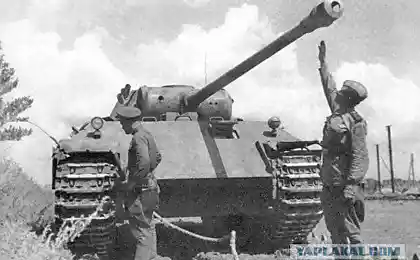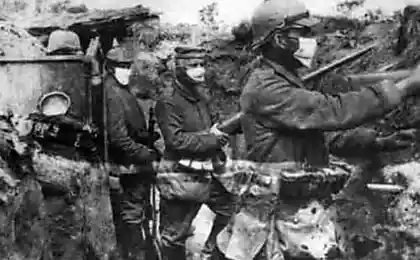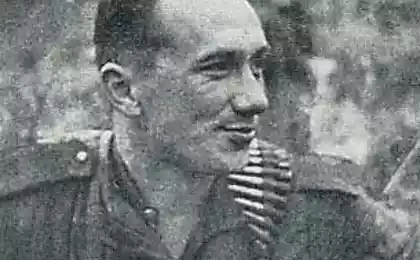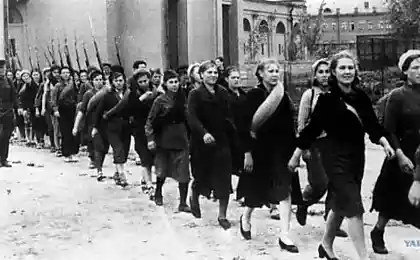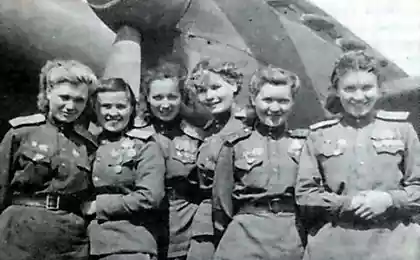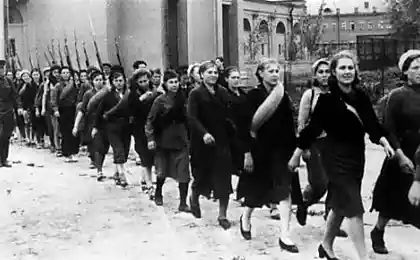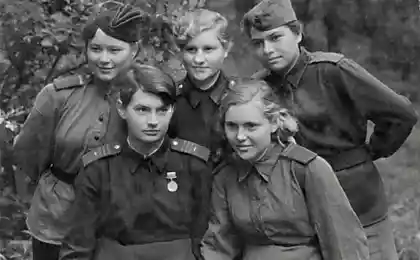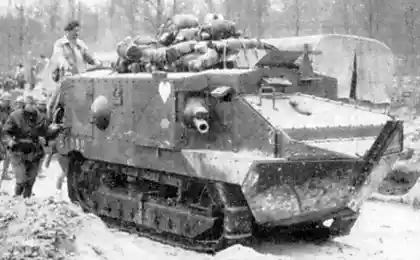951
Blitzkrieg on the Western Front (45 photos)
Rare photos of those times when Germany captured Europe and was thinking only to attack the USSR.
In the spring of 1940, Germany has established itself as the "conqueror of nations," to make a successful invasion and occupation of the six countries, less than 100 days.
In April 1940, Germany invaded Denmark, which surrendered just six hours.
Also Nazi warships and troops attacked Norway, which resisted for more than two months.
May 10 more than 2 million soldiers of the German troops on the ground and from the air invaded France, Belgium, Luxembourg and the Netherlands, using the tactics of blitzkrieg. Small countries capitulated in a few weeks, and France resisted until June 22, when the armistice was signed with Germany.
Also during this period, the Soviet Union launched the elections in Estonia, Latvia and Lithuania, forcibly annexing these states. By late summer, the German troops started planning the Battle of Britain.
German tank June 21, 1940 crosses the river Aisne in France, the day before the surrender of France. (AP Photo)
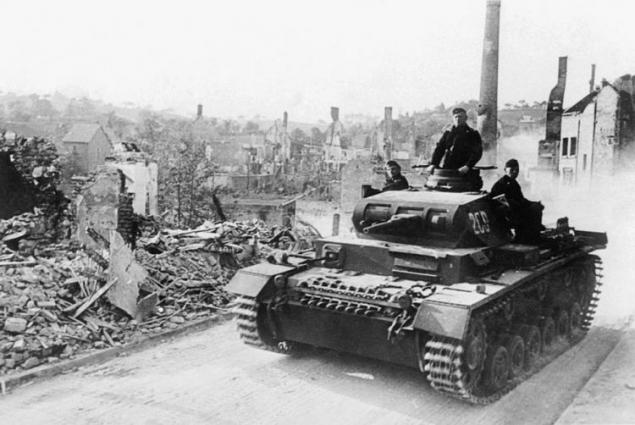
Waves German paratroopers land on the snow-covered ledges near the Norwegian port of Narvik and. (AP Photo)
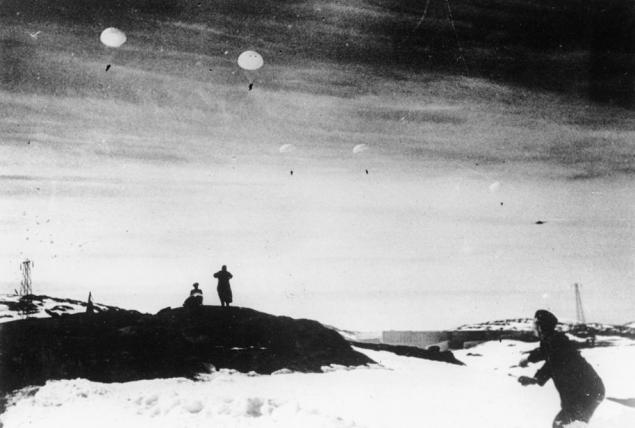
After the sea battle in Narvik, Norway in 1940. Several battles between German and Norwegian forces took place in the spring of 1940 Ofotfiord. (LOC)

A group of German Gebirgsjägers (mountain troops) in action in Narvik, Norway, in 1940. (Deutsches Bundesarchiv / German Federal Archive)
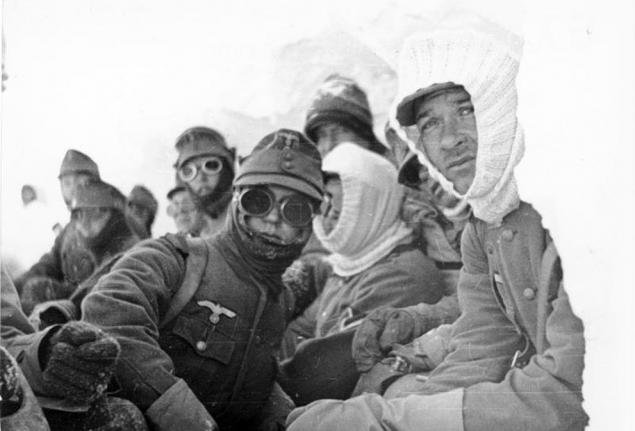
German soldiers run through a burning Norwegian village in April 1940. (AP Photo)

The pilots of the British bomber squadron of the Royal Air Force April 22, 1940, after returning to base after an attack on German warships in the area of Bergen, Norway. (AP Photo)
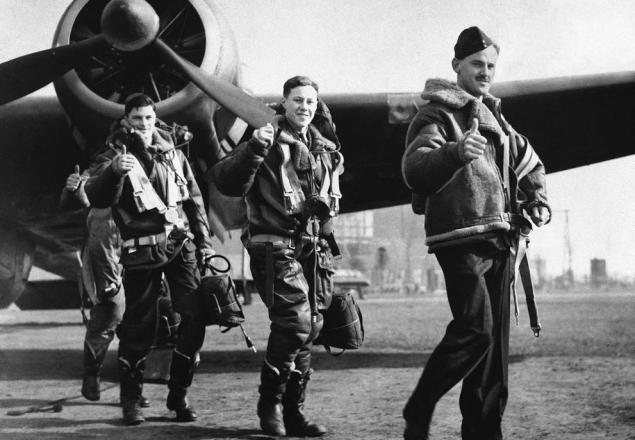
The observer for the aircraft on the roof of a building in London, England, St. Paul's Cathedral in the background. (National Archives).
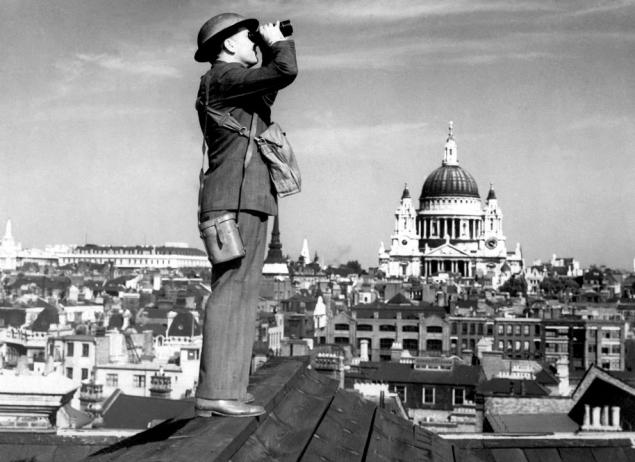
German bombs passed their goals and explode into the sea during an air raid on the Dover, England, July 1940. (AP Photo)
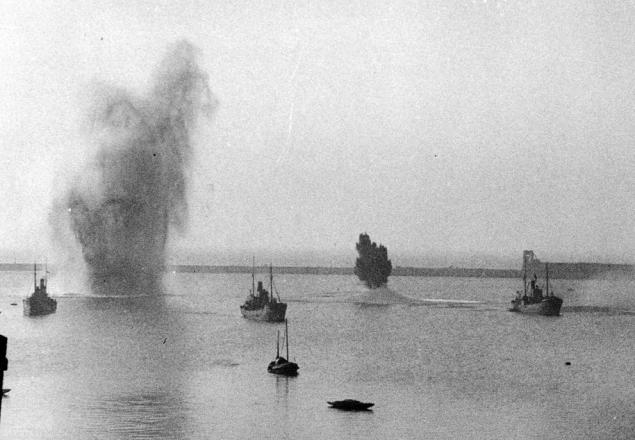
The members of the Black Watch, one of the famous Scottish regiments, trained in the Southern sector of the coast of England, in 1940. Soldiers are trained to combat paratroopers. (AP Photo).
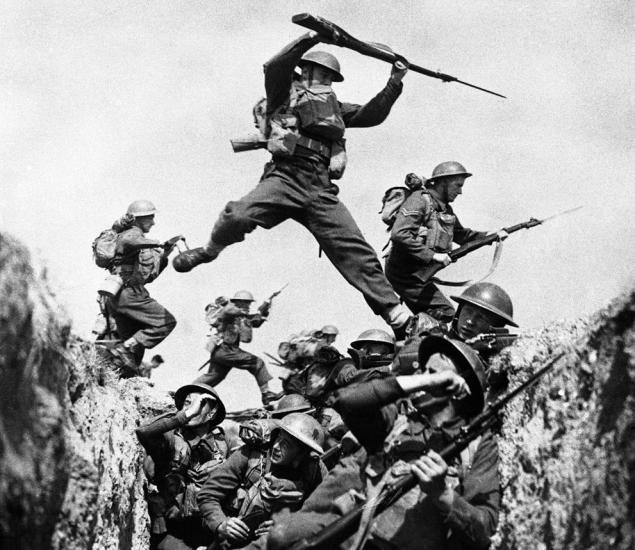
Royal Irish Fusiliers of the British expeditionary forces came to the aid of French farmers, whose horses were requisitioned in the French army. Wedgies harnessed to a plow to help plow the soil. March 27, 1940. (AP Photo)

Belgian woman tearfully say goodbye to their husbands and sons are sent to the front line, 11 May 1940. (AP Photo).

Group notorious German bombers flying Ju 87 Stuck in an unknown direction, May 29 1940. (AP Photo)
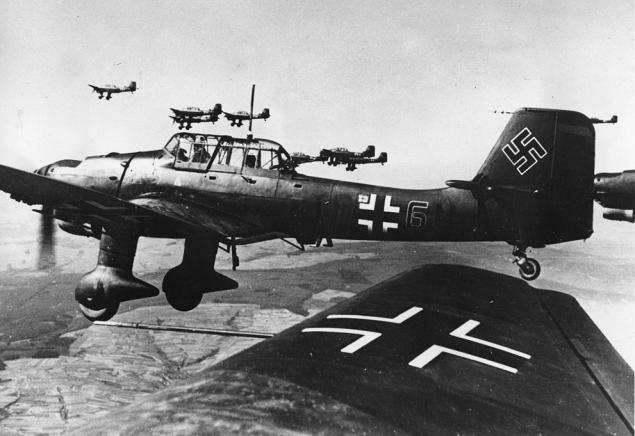
German soldiers for anti-aircraft gun at an undisclosed location, covers German troops marshiruschie on Danish territory, April 9, 1940. (AP Photo)
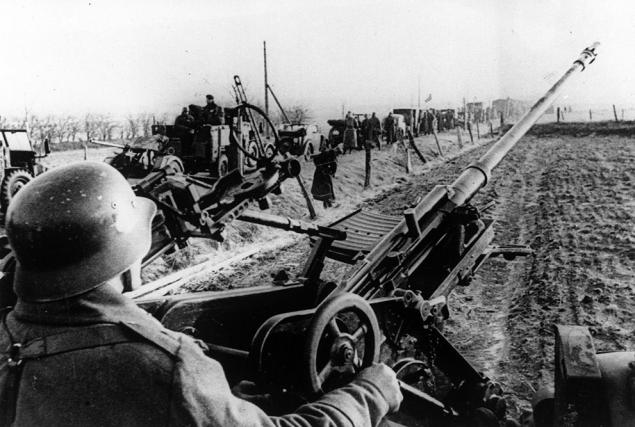
Advanced detachments of German troops enter in Luxembourg, 10 May 1940. (AP Photo)

German troops parachuted down to the impregnable fort Eben Emael in Belgium, May 10, 1940 (AP Photo). In the background freighter Ju-52, making a U-turn.
During this operation, a detachment of German paratroopers (85 men) under the leadership of Oberleutnant Rudolf Vittsiga during the day May 10, 1940 stormed the heavily fortified strategic Belgian fort Fort Eben-Emael (20 km north of Liege).

French soldiers were charged with artillery shells in the woods somewhere on the Western Front 29 May, 1940. (AP Photo)
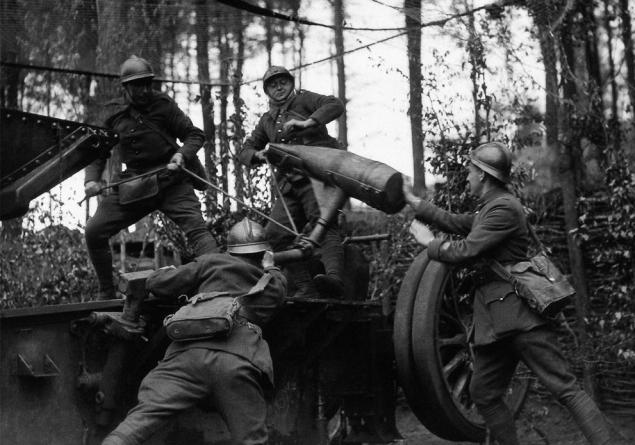
A group of German bombers Dornier Do 17Z over France June 21, 1940. (Deutsches Bundesarchiv / German Federal Archive)

Machine-gun crew of the German parachute troops in the Netherlands, June 2, 1940. This photo was found in the personal effects of the German paratroopers captured. (AP Photo).
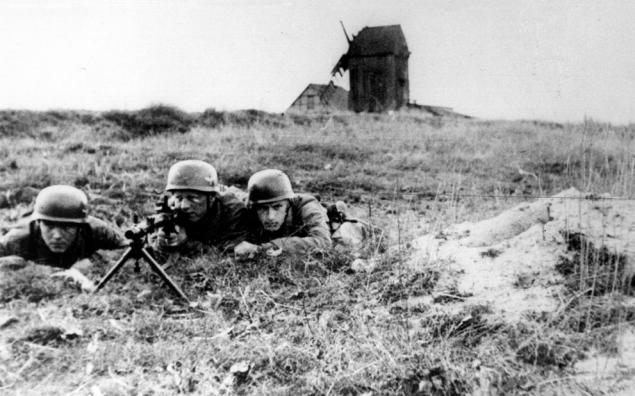
Belgians blew up the bridge over the river Meuse in Dinant, Belgium, but nemtskie engineers quickly erected next to the old wooden, June 20, 1940. (AP Photo)

Woman running from her home with belongings, hiding behind a tree on the side of the road, somewhere in Belgium, May 18, 1940, during the Nazi air attack aircraft. Her bike tied things rests on the tree behind which she hides. (AP Photo).
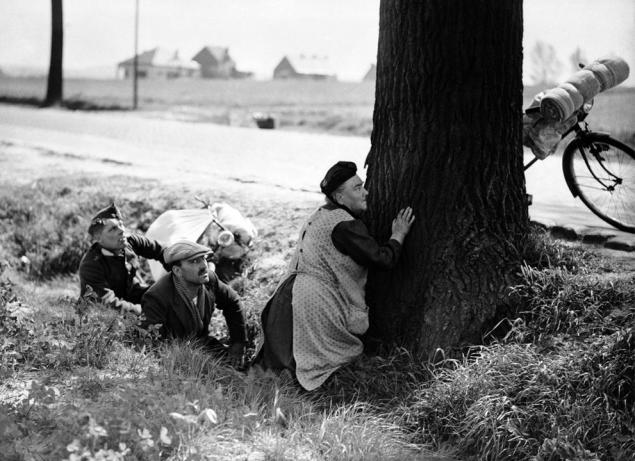
Hundreds of thousands of British and French troops, who fled from the advancing German troops gathered on the beaches of Dunkirk, France, June 4, 1940 in anticipation of the courts, which will forward them to England. (AP Photo).

British and French troops wade through shallow water along the beach at Dunkirk, France, June 13, 1940 to a small rescue to sail to England. About 700 private vessels joined dozens of warships to transport troops across the Channel. (AP Photo
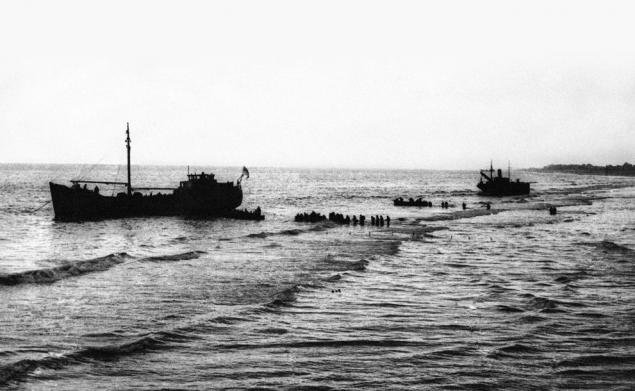
Men of the British Expeditionary Force arrived safely home after a battle in Flanders 6 June 1940. More than 330,000 soldiers were rescued from Dunkirk through the operation "Dynamo". (AP Photo)

Oil tanks burn in Dunkirk, France, June 5, 1940. In the lower right corner of the RAF Lockheed Hudson aircraft while on patrol. (AP Photo).
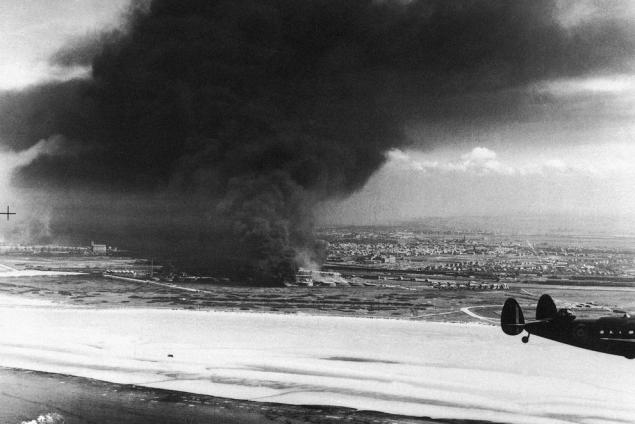
The consequences of the British retreat in Flanders, Belgium July 31, 1940. British soldiers lie dead beside their cars. (AP Photo).

British and French prisoners of war sitting near the railroad tracks in Belgium in 1940. (Deutsches Bundesarchiv German Federal Archives)
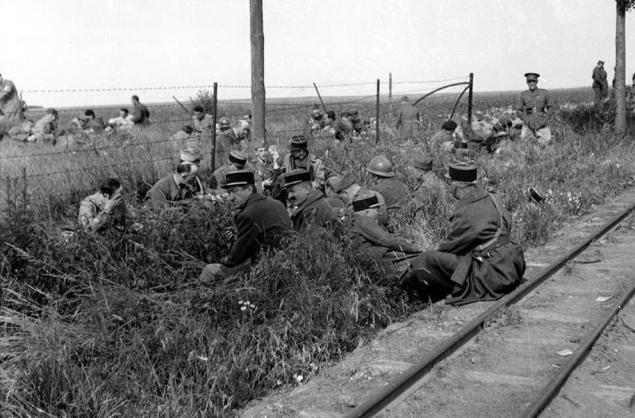
German troops parade in Copenhagen, Denmark, April 20, 1940 on the occasion of Hitler's birthday. (AP Photo).

Amsterdam, the Netherlands. Dutch man, seriously wounded in the head, arm and leg, looks in horror at the mutilated corpse of his daughter. 1940. (LOC)
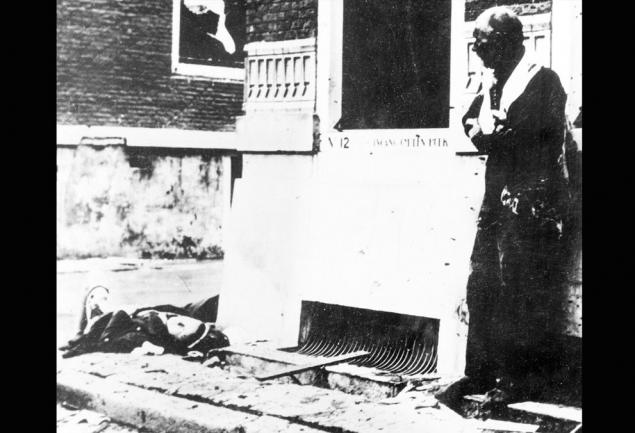
Killed by German soldiers, one of the many thousands who died during the invasion in 1940, somewhere in France, June 9, 1940. (AP Photo).

French tanks moved to the front lines through the bombed-out city frantszsky, May 25, 1940. (AP Photo).
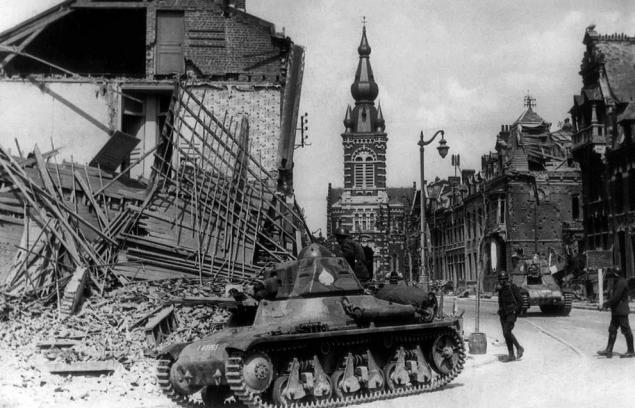
Women waving Yunina Jack (British flag), welcoming the passing soldiers Canadians, after their return from France, June 18, 1940. (AP Photo)

Some of the 350 British refugee children who arrived in New York on 8 July 1940 aboard the British ship "Samaria". They were the first among the large contingent of British children evacuated from the British Isles, on the eve of the forthcoming Nazi invasion, which schitalo very likely. (AP Photo / Becker)
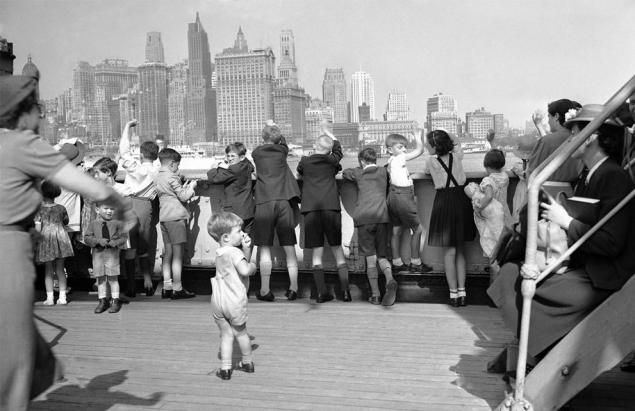
German soldiers are on a deserted street in Luxembourg with rifles, pistols and grenades, ready to defend themselves. May 21, 1940, (AP Photo)
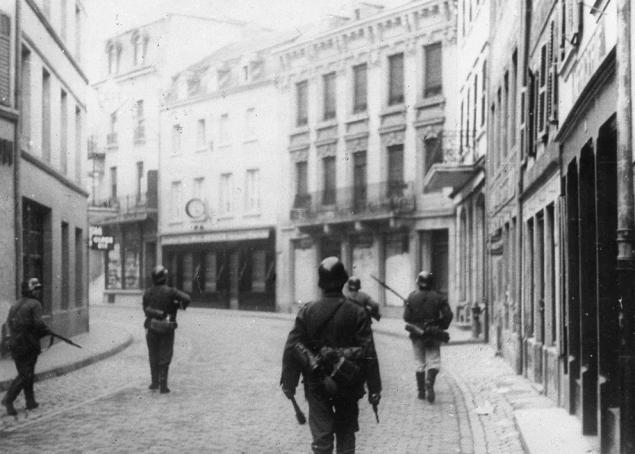
Falling bombs RAF during a raid on the airfield Abbeville, who took the Germans. France, July 20, 1940 (AP Photo).
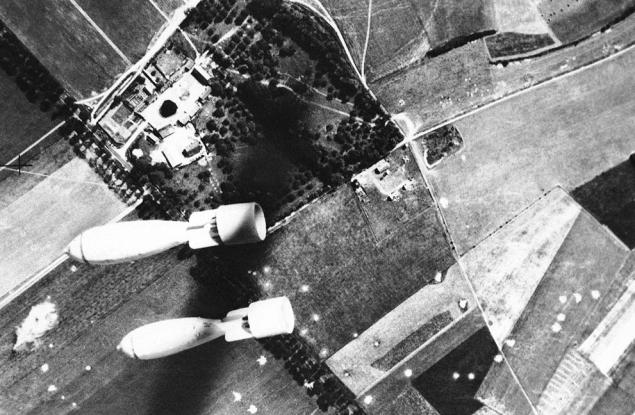
Refugees leave their ruined cities in Belgium, after the German bombing, May 19, 1940. (AP Photo)
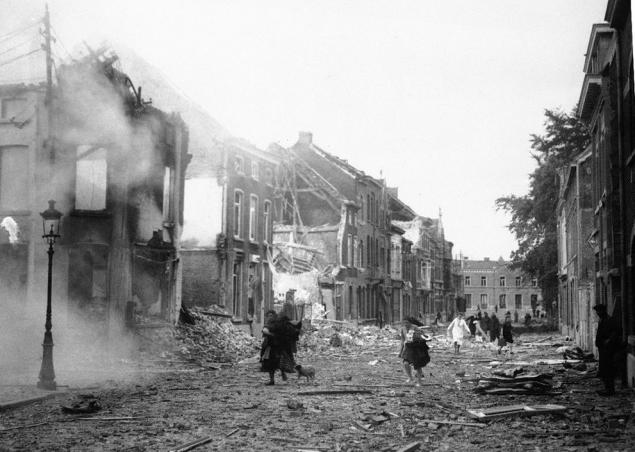
Nazi motorcyclists passing through the ruined city in France in 1940. (Deutsches Bundesarchiv / German Federal Archive).

The crowd of women, children and soldiers Wehrmacht raise their hands in a Nazi salute June 19, 1940 at an undisclosed location in Germany. (AP Photo)

Civilian victims of the German air raid near Antwerp, Belgium, June 13, 1940. British soldaly said that these people were going to bike to work, when German planes to find them, fired near the wheat field. (AP Photo).
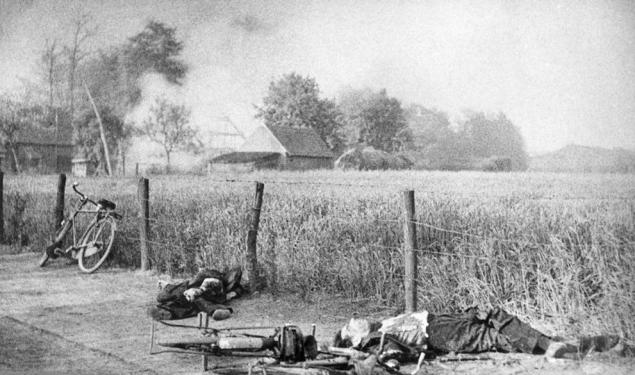
British Prime Minister Winston Churchill checks grenadiers standing at attention. July 1940. (AP Photo)

Allied soldiers pushes on the piston of an explosive mechanism, which will destroy the bridge to delay the Nazi advance in the area of Leuven in Belgium, June 1, 1940, the day before the date of this area to the Germans. (AP Photo).

Belgian family on a tandem bike running from the advancing Nazis in France, 14 June 1940. (AP Photo).

Adolf Hitler in Paris, posing against the backdrop of the Eiffel Tower, the day after the formal capitulation of France June 23, 1940.
He is accompanied by Albert Speer (left), German Reich minister of armaments, and Arno Breker, a professor of Fine Arts in Berlin and Hitler's favorite sculptor (right). Unknown operator is seen in the foreground subject.
Photos provided by the German military department. (AP Photo / German Ministry of War)
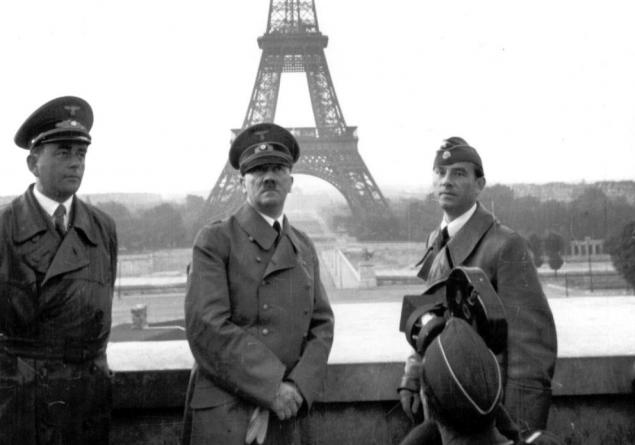
French destroyer Mogador, on fire after the bombing of British ships at Mers-el-Kebir, French Algeria, July 3, 1940. After the signing of the armistice with Germany, France, the British government decided to destroy as much as possible, the French warships to prevent them from falling into the hands of the Nazis. The operation resulted in several ships were badly damaged, one sank. 1297 French sailors were killed during this attack.
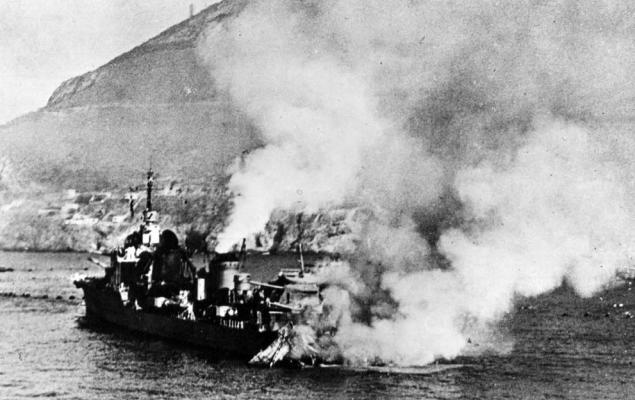
Heavy mortars German Army established under rocks on the French side of the English Channel, in Fecamp, France, 1940.

A German soldier stands on a tower of the cathedral, looking down on the captured French city of Strasbourg July 15, 1940. Adolf Hitler visited the city in June 1940, declaring that the cathedral of Strasbourg, should be a "national sanctuary of the German people." (AP Photo)
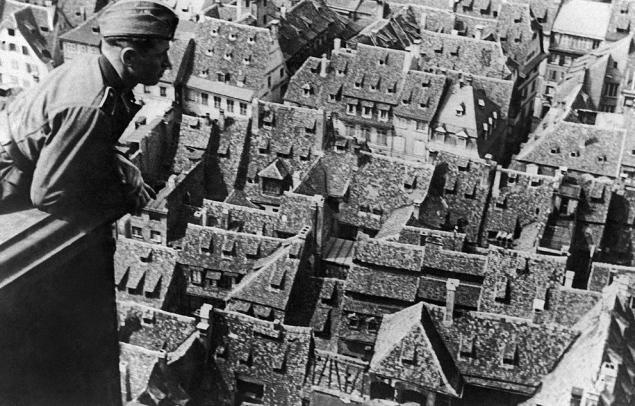
In the spring of 1940, Germany has established itself as the "conqueror of nations," to make a successful invasion and occupation of the six countries, less than 100 days.
In April 1940, Germany invaded Denmark, which surrendered just six hours.
Also Nazi warships and troops attacked Norway, which resisted for more than two months.
May 10 more than 2 million soldiers of the German troops on the ground and from the air invaded France, Belgium, Luxembourg and the Netherlands, using the tactics of blitzkrieg. Small countries capitulated in a few weeks, and France resisted until June 22, when the armistice was signed with Germany.
Also during this period, the Soviet Union launched the elections in Estonia, Latvia and Lithuania, forcibly annexing these states. By late summer, the German troops started planning the Battle of Britain.
German tank June 21, 1940 crosses the river Aisne in France, the day before the surrender of France. (AP Photo)

Waves German paratroopers land on the snow-covered ledges near the Norwegian port of Narvik and. (AP Photo)

After the sea battle in Narvik, Norway in 1940. Several battles between German and Norwegian forces took place in the spring of 1940 Ofotfiord. (LOC)

A group of German Gebirgsjägers (mountain troops) in action in Narvik, Norway, in 1940. (Deutsches Bundesarchiv / German Federal Archive)

German soldiers run through a burning Norwegian village in April 1940. (AP Photo)

The pilots of the British bomber squadron of the Royal Air Force April 22, 1940, after returning to base after an attack on German warships in the area of Bergen, Norway. (AP Photo)

The observer for the aircraft on the roof of a building in London, England, St. Paul's Cathedral in the background. (National Archives).

German bombs passed their goals and explode into the sea during an air raid on the Dover, England, July 1940. (AP Photo)

The members of the Black Watch, one of the famous Scottish regiments, trained in the Southern sector of the coast of England, in 1940. Soldiers are trained to combat paratroopers. (AP Photo).

Royal Irish Fusiliers of the British expeditionary forces came to the aid of French farmers, whose horses were requisitioned in the French army. Wedgies harnessed to a plow to help plow the soil. March 27, 1940. (AP Photo)

Belgian woman tearfully say goodbye to their husbands and sons are sent to the front line, 11 May 1940. (AP Photo).

Group notorious German bombers flying Ju 87 Stuck in an unknown direction, May 29 1940. (AP Photo)

German soldiers for anti-aircraft gun at an undisclosed location, covers German troops marshiruschie on Danish territory, April 9, 1940. (AP Photo)

Advanced detachments of German troops enter in Luxembourg, 10 May 1940. (AP Photo)

German troops parachuted down to the impregnable fort Eben Emael in Belgium, May 10, 1940 (AP Photo). In the background freighter Ju-52, making a U-turn.
During this operation, a detachment of German paratroopers (85 men) under the leadership of Oberleutnant Rudolf Vittsiga during the day May 10, 1940 stormed the heavily fortified strategic Belgian fort Fort Eben-Emael (20 km north of Liege).

French soldiers were charged with artillery shells in the woods somewhere on the Western Front 29 May, 1940. (AP Photo)

A group of German bombers Dornier Do 17Z over France June 21, 1940. (Deutsches Bundesarchiv / German Federal Archive)

Machine-gun crew of the German parachute troops in the Netherlands, June 2, 1940. This photo was found in the personal effects of the German paratroopers captured. (AP Photo).

Belgians blew up the bridge over the river Meuse in Dinant, Belgium, but nemtskie engineers quickly erected next to the old wooden, June 20, 1940. (AP Photo)

Woman running from her home with belongings, hiding behind a tree on the side of the road, somewhere in Belgium, May 18, 1940, during the Nazi air attack aircraft. Her bike tied things rests on the tree behind which she hides. (AP Photo).

Hundreds of thousands of British and French troops, who fled from the advancing German troops gathered on the beaches of Dunkirk, France, June 4, 1940 in anticipation of the courts, which will forward them to England. (AP Photo).

British and French troops wade through shallow water along the beach at Dunkirk, France, June 13, 1940 to a small rescue to sail to England. About 700 private vessels joined dozens of warships to transport troops across the Channel. (AP Photo

Men of the British Expeditionary Force arrived safely home after a battle in Flanders 6 June 1940. More than 330,000 soldiers were rescued from Dunkirk through the operation "Dynamo". (AP Photo)

Oil tanks burn in Dunkirk, France, June 5, 1940. In the lower right corner of the RAF Lockheed Hudson aircraft while on patrol. (AP Photo).

The consequences of the British retreat in Flanders, Belgium July 31, 1940. British soldiers lie dead beside their cars. (AP Photo).

British and French prisoners of war sitting near the railroad tracks in Belgium in 1940. (Deutsches Bundesarchiv German Federal Archives)

German troops parade in Copenhagen, Denmark, April 20, 1940 on the occasion of Hitler's birthday. (AP Photo).

Amsterdam, the Netherlands. Dutch man, seriously wounded in the head, arm and leg, looks in horror at the mutilated corpse of his daughter. 1940. (LOC)

Killed by German soldiers, one of the many thousands who died during the invasion in 1940, somewhere in France, June 9, 1940. (AP Photo).

French tanks moved to the front lines through the bombed-out city frantszsky, May 25, 1940. (AP Photo).

Women waving Yunina Jack (British flag), welcoming the passing soldiers Canadians, after their return from France, June 18, 1940. (AP Photo)

Some of the 350 British refugee children who arrived in New York on 8 July 1940 aboard the British ship "Samaria". They were the first among the large contingent of British children evacuated from the British Isles, on the eve of the forthcoming Nazi invasion, which schitalo very likely. (AP Photo / Becker)

German soldiers are on a deserted street in Luxembourg with rifles, pistols and grenades, ready to defend themselves. May 21, 1940, (AP Photo)

Falling bombs RAF during a raid on the airfield Abbeville, who took the Germans. France, July 20, 1940 (AP Photo).

Refugees leave their ruined cities in Belgium, after the German bombing, May 19, 1940. (AP Photo)

Nazi motorcyclists passing through the ruined city in France in 1940. (Deutsches Bundesarchiv / German Federal Archive).

The crowd of women, children and soldiers Wehrmacht raise their hands in a Nazi salute June 19, 1940 at an undisclosed location in Germany. (AP Photo)

Civilian victims of the German air raid near Antwerp, Belgium, June 13, 1940. British soldaly said that these people were going to bike to work, when German planes to find them, fired near the wheat field. (AP Photo).

British Prime Minister Winston Churchill checks grenadiers standing at attention. July 1940. (AP Photo)

Allied soldiers pushes on the piston of an explosive mechanism, which will destroy the bridge to delay the Nazi advance in the area of Leuven in Belgium, June 1, 1940, the day before the date of this area to the Germans. (AP Photo).

Belgian family on a tandem bike running from the advancing Nazis in France, 14 June 1940. (AP Photo).

Adolf Hitler in Paris, posing against the backdrop of the Eiffel Tower, the day after the formal capitulation of France June 23, 1940.
He is accompanied by Albert Speer (left), German Reich minister of armaments, and Arno Breker, a professor of Fine Arts in Berlin and Hitler's favorite sculptor (right). Unknown operator is seen in the foreground subject.
Photos provided by the German military department. (AP Photo / German Ministry of War)

French destroyer Mogador, on fire after the bombing of British ships at Mers-el-Kebir, French Algeria, July 3, 1940. After the signing of the armistice with Germany, France, the British government decided to destroy as much as possible, the French warships to prevent them from falling into the hands of the Nazis. The operation resulted in several ships were badly damaged, one sank. 1297 French sailors were killed during this attack.

Heavy mortars German Army established under rocks on the French side of the English Channel, in Fecamp, France, 1940.

A German soldier stands on a tower of the cathedral, looking down on the captured French city of Strasbourg July 15, 1940. Adolf Hitler visited the city in June 1940, declaring that the cathedral of Strasbourg, should be a "national sanctuary of the German people." (AP Photo)




